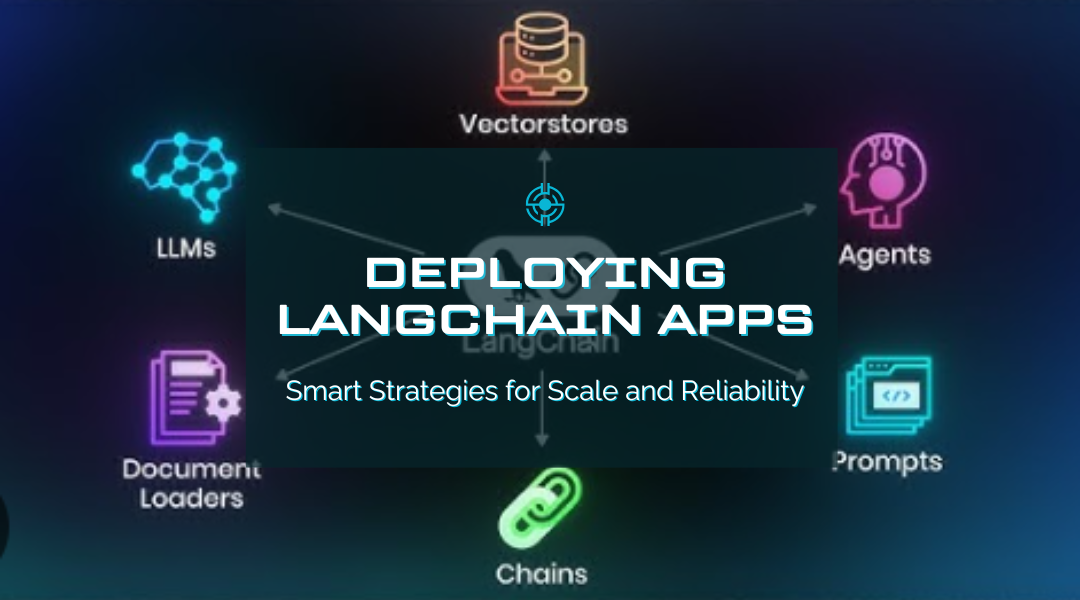Launching a LangChain application isn’t just about writing code—it’s about making sure it runs smoothly, scales effortlessly, and stays resilient when traffic surges. Whether you’re building a real-time chatbot, a data processing pipeline, or an AI-driven workflow, your deployment strategy can make or break the user experience.
Let’s break down the key decisions and best practices to ensure your app performs under pressure.
1. Choosing the Right Deployment Approach
Not all apps are built the same, and neither should their deployments be. Here’s how to match your setup with your needs:
A. What’s Your App’s Workload?
- Real-time interactions (e.g., live chat, instant responses) → Serverless (AWS Lambda, Cloud Functions) or cloud-native setups (Google App Engine).
- Heavy computations (e.g., batch processing, model training) → Containerized deployments (Docker + Kubernetes).
- Unpredictable traffic spikes (e.g., marketing campaigns, event-driven apps) → Auto-scaling cloud services (AWS Fargate, Azure Container Apps).
B. How Much Traffic Are You Expecting?
- Low to moderate traffic? A simple cloud VM (DigitalOcean Droplet, EC2) might suffice.
- Steady high demand? Kubernetes clusters distribute load efficiently.
- Bursty traffic? Go serverless—you only pay for what you use.
C. Budget vs. Performance Trade-offs
- Tight budget? Start with serverless—minimal upfront costs.
- Need predictable costs? Reserved cloud instances (AWS Reserved Instances, GCP Committed Use).
- Enterprise-grade? Kubernetes offers flexibility but demands DevOps expertise.
D. Security & Compliance Needs
- Handling sensitive data? Private cloud or on-premises deployments keep control in-house.
- General use? Public clouds (AWS, Azure) offer built-in compliance (SOC 2, HIPAA).
E. Global Users? Optimize for Latency
Deploy in regions closest to your users—AWS’s multi-region setup or Cloudflare’s edge network can cut response times.
F. Does It Play Well with Your Existing Tools?
- AWS ecosystem? Lambda + DynamoDB + API Gateway work seamlessly together.
- Google Cloud fans? BigQuery + Vertex AI streamline AI workflows.
- Microsoft stack? Azure’s tight integration with Power BI and Active Directory simplifies deployments.
2. Keeping Your App Fast & Reliable Under Load
When traffic spikes, a poorly optimized app can buckle. Here’s how to stay ahead:
A. Distribute Traffic with Load Balancers
- Managed option: AWS ALB (Application Load Balancer) scales automatically.
- Custom control: NGINX or HAProxy for fine-grained routing.
How it works:
User requests → Load balancer → Multiple backend servers
B. Auto-Scaling: Grow (or Shrink) on Demand
- Cloud VMs: AWS Auto Scaling adjusts server count based on CPU usage.
- Kubernetes: Horizontal Pod Autoscaler (HPA) adds more containers when needed.
Example Kubernetes HPA setup:
yaml
Copy
Download
apiVersion: autoscaling/v2
kind: HorizontalPodAutoscaler
metadata:
name: langchain-scaler
spec:
scaleTargetRef:
apiVersion: apps/v1
kind: Deployment
name: langchain-app
minReplicas: 2
maxReplicas: 15
metrics:
– type: Resource
resource:
name: cpu
target:
type: Utilization
averageUtilization: 60
C. Cache Frequently Accessed Data
- In-memory caching: Redis or Memcached speeds up repeated queries.
- Edge caching: Cloudflare or Fastly stores static content closer to users.
Python + Redis example:
python
Copy
Download
import redis
cache = redis.Redis(host=’cache.redis.com’, port=6379)
def get_cached_data(key, fallback_query):
cached = cache.get(key)
if cached:
return cached
fresh_data = fallback_query() # Fetch from DB if not in cache
cache.setex(key, 300, fresh_data) # Cache for 5 minutes
return fresh_data
D. Optimize Database Performance
- Add indexes to speed up frequent queries.
- Use read replicas to offload heavy read traffic.
E. Monitor Everything (Before It Breaks)
- Cloud-native: AWS CloudWatch tracks performance and triggers alerts.
- Self-hosted: Prometheus + Grafana for real-time dashboards.
Monitoring flow:
App metrics → Prometheus → Grafana dashboard → Slack/email alerts
F. Fail Gracefully with Circuit Breakers
If a service crashes, a circuit breaker (like Hystrix or resilience4j) can:
- Return cached data.
- Show a fallback message instead of an error.
Example: If your LLM API is slow, serve a pre-generated response instead of timing out.
G. Microservices: Isolate for Stability
Instead of one monolithic app, split it into smaller services:
- Chat service (handles user input).
- Query service (talks to the database).
- API service (connects to external tools).
Kubernetes makes managing these easier, but serverless (AWS Lambda + API Gateway) works too.
Key Takeaways
- Match deployment to your app’s needs—serverless for spiky traffic, Kubernetes for heavy workloads.
- Scale smartly—auto-scaling and load balancing keep performance smooth.
- Cache aggressively—Redis and CDNs prevent unnecessary database hits.
- Monitor proactively—catch issues before users do.
- Design for failure—circuit breakers and microservices keep small issues from becoming outages.
Deploying a LangChain app isn’t just about making it work—it’s about making it work well, no matter how many users hit it. By planning for scale, optimizing performance, and building in resilience, you’ll ensure a seamless experience, even when traffic goes wild.
